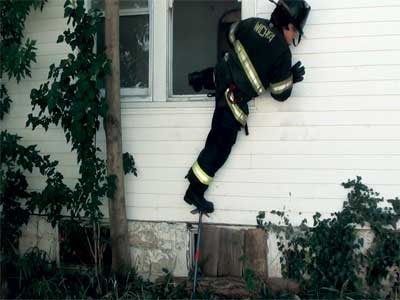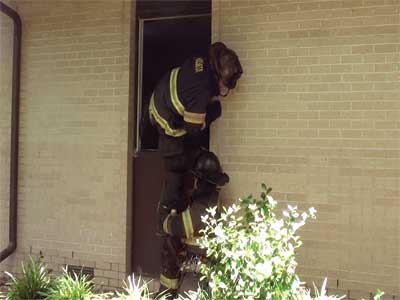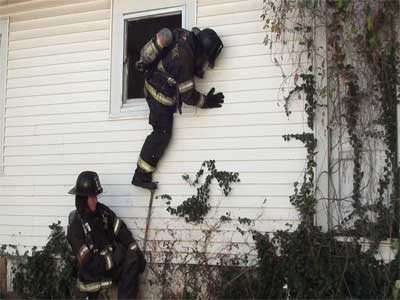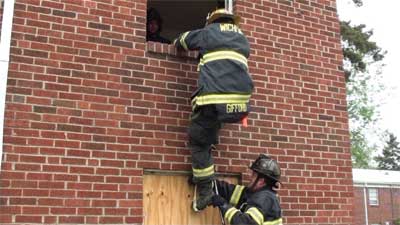BY SAMUEL HITTLE
THERE ARE A VARIETY OF reasons a firefighter may need to enter a structure through a window. Most of these reasons require doing so in a timely manner under adverse conditions. When performing vent-enter-search (VES), it is imperative to get in quickly so you can promptly isolate the room to prevent drawing fire to your location. Other times, although not ideal, you may have to stretch through a window. This, too, requires a fast ingress. In these and other scenarios, your ability to make entry on varying windowsill heights and floor levels in a judicious time frame is essential.
First, let’s review some basics. Before entering through a window, observe ventilation conditions while clearing the window components. Once you determine circumstances are favorable, notify command of the following: who you are, tactical objective, level, and building side (i.e., “Truck 1 is VESing second floor, Bravo side”). This transmission will also be advantageous to the rapid intervention team and engine company that may be making a push in your direction. Next, clear the immediate floor area by sweeping with a tool or visually inspecting for victims. Of course, it is important to check for structural stability, but in reality this is not always possible because of obstructions. If you do encounter obstructions, sound the floor once inside the structure. Finally, whenever possible, isolate your work area by shutting doors between the fire and you.
Window entry can be difficult, especially for tall firefighters, who may be tempted to enter headfirst. Although sometimes a headfirst entry is unavoidable, whenever possible it is best to roll the sill. Rolling the sill allows you to change your mind should conditions change or should structural circumstances not support interior access. If headfirst is the only option, spread your legs out, creating friction on the window frame to slow your ascent. This will reduce shock load on the floor and slow forward momentum that may cause deeper entry into the room than intended, disorienting you to the window egress.
A technique for rolling the sill that makes the maneuver less cumbersome is to slide back and forth on the sill. First, with your head out, drive your shoulder into the frame while supporting yourself by clasping the inside and outside wall. This will maximize the available space to swing your first leg in. Next, slide backward until your rear hits the opposite frame. Again, this will maximize space, allowing room to reposition your head inside without rising up high into the window. With self-contained breathing apparatus on, your ability to articulate your head is lessened, and you will notice the space difference. Finally, with your head inside, slide forward, driving your opposite shoulder into the frame to maximize space to swing your other leg inside. This is a good time to slowly load the floor with your weight. If you don’t like how it feels, you are still halfway out the window and can easily leave. Use the same procedure to exit.
Grade-level windows typically do not cause much grief, but it is worth revisiting some tried and true techniques. Firefighters operating independently can lean the halligan against the structure for a step, driving the pike slightly into the siding to reduce the probability of its sliding out from under them (photo 1). Once inside, it is easy to reclaim the tool.
 |
| (1) Drive the pike of the halligan into the siding when using it as a step to reduce the chances of its slipping. (Photos by author.) |
If two firefighters are working together, use a knee. Make sure the entry firefighter positions his foot so that the force transitions directly downward to the supporting firefighter’s base (or footing). Placing weight on the femur can lead to serious injury. The firefighter entering can use his tool for traction on the inside wall (photo 2).
 |
| (2) When working in pairs, using the knee of one firefighter will allow the other firefighter to enter the window with a tool already in hand. |
Depending on the construction, you may encounter high windows. Without a ladder available, you can still enter using hand tools. On frame construction with siding, drive the pike of the halligan into the structure as a secondary step; use a firefighter’s knee as the primary step (photo 3).
 |
| (3) Drive the pike of the halligan into the wall to create a secondary step when using another firefighter’s knee as the first step. |
When operating at a masonry finished building, you can use some looped webbing wrapped around the head of a roof hook in conjunction with a knee. Once the webbing is secured to the hook, lean it against the wall with the butt end wedged on the inside of the supporting firefighter’s foot to prevent it from slipping, support the hook and webbing in one hand, and reach behind the hook to open a loop that will support the foot placement of the entering firefighter. You can use the top of the roof hook as an additional step on really high windows (photo 4).
 |
| (4) On masonry buildings, use a short webbing loop in conjunction with a six-foot roof hook to create the second step using a knee and the top of the hook. |
When making entry off a ladder, place the ladder below the windowsill at a 60º angle. Keep the beams out of the opening to aid in sliding and rolling the sill, victim removal, and headfirst bailout if required. To prevent the ladder from sliding if your weight shifts and to maintain orientation with your egress, it is important to maintain ladder contact with one hand at all times unless sweeping or sounding the floor (photo 5).
 |
| (5) When entering from a ladder, it is important to keep one hand on the ladder to maintain orientation with the egress and to prevent the beams from sliding. |
These quick and efficient tips can help you achieve rapid entry through a window with the tools you have available.
SAMUEL HITTLE is a lieutenant in the Wichita (KS) Fire Department. He has an associate degree in fire science, is an FDIC and Wichita H.O.T. instructor, is an FDIC classroom instructor, and is a contributing author to Fire Engineering and Urban Firefighter.
Fire Engineering Archives

